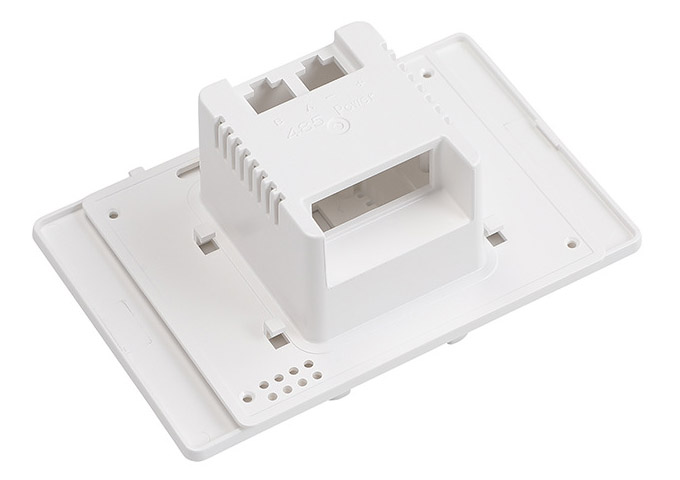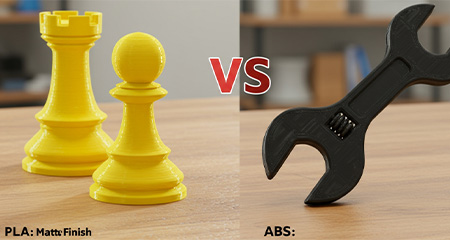PLA vs. ABS: A Guide to the Difference
Struggling to choose between PLA and ABS for your 3D printing project? Picking the wrong material could lead to print failure, poor finish, or wasted time and cost. Let’s fix that. PLA is ideal for beginners with easy printing and clean surface finish, while ABS is preferred for industrial strength and thermal resistance. Here’s how they compare in every key aspect.
Read on to learn which material is best for your project, from function to appearance.
What is PLA?
PLA is a bio-based thermoplastic derived from renewable resources like corn starch or sugarcane. As one of the most popular 3D printing plastic filament types, it’s praised for ease of use, affordability, and environmental friendliness.
PLA filament melts at lower temperatures, reducing warping and making it suitable for hobbyists and rapid prototyping. Its biodegradable nature makes it appealing for short-term, display-ready applications, though it lacks the toughness for high-impact or heat-intensive uses.
What is ABS?
ABS, or Acrylonitrile Butadiene Styrene, is a petroleum-based thermoplastic known for its strength, durability, and resistance to heat. It is widely used in ABS prototype development, automotive parts, and functional industrial components.
ABS 3D printing filament requires higher extrusion temperatures and a heated bed to avoid warping. Though harder to print than PLA, it provides superior mechanical properties and long-term performance under stress or elevated temperatures.

How Accurate is 3D Printing with PLA Compared to ABS?
PLA and ABS filaments differ in their dimensional accuracy, primarily due to their material properties and behavior during printing. PLA typically offers better precision with a tolerance of ±0.1 mm, thanks to its lower shrinkage and minimal warping, making it ideal for applications requiring stability and fine details.
In contrast, ABS has a tolerance of ±0.2 mm and is more prone to warping and curling, especially without a controlled printing environment. While ABS may not achieve the same level of resolution as PLA, it is still suitable for robust applications where its strength and thermal resistance are necessary.
Which Material Is Easier to Print: PLA or ABS?
PLA is hands-down easier to print, requiring lower temperatures and no heated bed. It sticks well to most surfaces, needs minimal enclosure, and is beginner-friendly. In contrast, ABS demands precise temperature control, a heated chamber, and even air filtration.
So if you’re prototyping cosmetic enclosures or quick mockups, PLA plastic filament is your go-to.
How Do PLA and ABS Compare in Strength and Durability?
ABS 3D print filament is significantly more durable, especially under thermal stress and physical impact. It’s widely used in automotive and industrial parts due to its UTS of ABS filament properties. PLA, while strong enough for most display or low-load parts, becomes brittle over time or under heat.

Can PLA and ABS Be Used Together?
Not effectively. Despite similar base printing technologies, PLA vs ABS materials have very different extrusion temperatures and bonding characteristics, making them unsuitable for hybrid prints. A dual extrusion printer with temperature isolation might work, but the parts’ structural integrity may be compromised.
What Are the Differences in Surface Finish for PLA vs. ABS?
PLA delivers a glossy, detailed finish straight off the printer. ABS, however, often looks dull initially but can be polished using acetone vapor smoothing for a professional look. For 3D printer materials explained in terms of aesthetics, PLA wins on out-of-the-box appearance, but ABS excels with post-processing.
Is PLA or ABS More Environmentally Friendly?
PLA is the more environmentally friendly option compared to ABS. Derived from renewable resources like cornstarch or sugarcane, PLA is biodegradable under industrial composting conditions, making it a more sustainable choice. Additionally, the production process for PLA typically has a smaller carbon footprint, further enhancing its eco-credentials.
In contrast, ABS is petroleum-based, non-biodegradable, and can release toxic fumes during printing or incineration. Improper disposal of ABS contributes to long-term environmental harm, as it does not naturally decompose.
What Are the Applications of PLA and ABS?
PLA is well-suited for applications where visual appeal and ease of use are prioritized. Its high resolution and minimal warping make it ideal for product design prototypes, display models, and creative projects like toys, gadgets, and 3D pen creations. The filament’s biodegradable nature and low printing temperature also make it accessible for beginners.
ABS, on the other hand, excels in applications demanding durability and heat resistance. It is commonly used for functional mechanical parts, electronic enclosures, and automotive interior components, where strength and thermal stability are critical.
What Are the Key Differences Between PLA and ABS?
When choosing between PLA and ABS for your 3D printing projects, it’s essential to understand their unique characteristics and suitability for various applications. Below summarize the key differences and strengths of each filament to help you make an informed decision.
| Criteria | PLA | ABS |
|---|---|---|
| Biodegradable | Yes | No |
| Print Temperature | 180–220°C | 220–250°C |
| Heated Bed Required | No | Yes |
| Ease of Printing | High | Moderate |
| Strength | Moderate | High |
| Strength Under Stress | Lower | Better resistance |
| Glass Transition | N/A | Around 105°C |
| Finish Quality | Smooth, glossy | Matte, can be polished |
| Environment Friendliness | Biodegradable | Non-biodegradable |
| Odor During Printing | Low odor | Noticeable plastic smell |
| Best For | Prototypes, toys, visual models | Functional, load-bearing parts |
| CNC Machining Compatible | Limited (soft) | More durable for post-machining |
Start Your 3D Printing and CNC Machining Project at VMT
Whether you’re building concept models in PLA, performance-ready parts in ABS, or combining them with CNC precision machining, VMT is your one-stop solution. With 100+ advanced machines and tolerances down to 0.01 mm, we offer filament for 3D printing and high-speed machining services under one roof, serving automotive, electronics, medical, and industrial sectors globally.

In Conclusion
PLA is perfect for projects that prioritize ease of use, a glossy finish, and eco-friendliness, making it ideal for prototypes, toys, and decorative models. ABS, however, is better for demanding applications requiring strength, durability, and heat resistance, such as functional parts or professional use. Choose PLA for simplicity and sustainability, and ABS for toughness and advanced performance.
Frequently Asked Questions About PLA and ABS
Are PLA and ABS Filaments Heat Resistant?
ABS offers better heat resistance with a glass transition temperature around 105°C, making it more suitable for high-temperature applications. PLA, on the other hand, begins to deform around 60°C. While PLA is easier to print, it’s not ideal for parts exposed to heat or sunlight.
What is the Part Accuracy of PLA and ABS?
Both PLA and ABS 3D print filament can achieve high dimensional accuracy, typically within ±0.1 mm on well-calibrated printers. PLA tends to hold tighter tolerances due to lower warping. However, ABS 3D printer filament may require enclosed printers and post-processing for better accuracy. For fine details and small tolerances, PLA usually provides better consistency.
How Strong Are PLA and ABS Parts?
ABS is generally stronger and more impact-resistant than PLA, making it suitable for functional parts. PLA is stiffer but more brittle, meaning it can crack under pressure. If tensile strength and shock resistance are key, ABS 3D printing material properties are superior. However, PLA strength is sufficient for static, decorative, or low-stress applications.
Are PLA and ABS Flexible?
Neither PLA nor ABS are known for high flexibility, but ABS is more ductile and can bend without breaking. PLA is stiffer and prone to snapping under stress. For slightly flexible applications, ABS 3D print filament is the better choice. For high-flexibility needs, consider alternatives like TPU or nylon instead of PLA filament or ABS.
Is PLA or ABS More Expensive?
PLA is usually cheaper than ABS, both in filament price and printing requirements. PLA filament for 3D printing doesn’t need heated beds or enclosures, reducing equipment costs. ABS 3D printer filament may have slightly higher material cost and needs controlled conditions, raising total cost. For budget-friendly prototyping, PLA is more economical.



